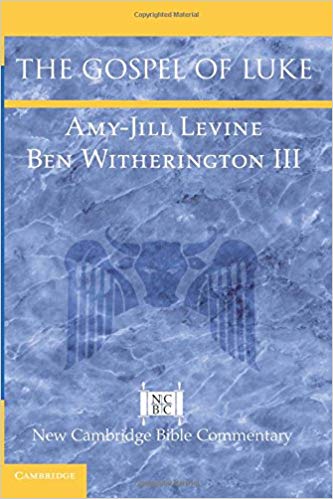(This review just appeared in the SBL review of books available online through the SBL website—This review was published by RBL 2019 by the Society of Biblical Literature. For more information on obtaining a
subscription to RBL, please visit http://www.bookreviews.org/subscribe.asp.).
Amy-Jill Levine and Ben Witherington III
The Gospel of Luke
New Cambridge Bible Commentary
Cambridge: Cambridge University Press, 2018. Pp. x +
715. Paper. $39.99. ISBN 9780521676816.
Troy M. Troftgruben
Wartburg Seminary
In the field of New Testament studies, Amy-Jill Levine and Ben Witherington hardly need
introduction. Besides holding distinguished chairs at their schools (Vanderbilt, Asbury
Seminary), both serve as editors for major New Testament commentary series and have
extensive publications of note. In this volume, they join in what seems an unprecedented
work of collaboration: an exegetical and theological commentary on a New Testament
gospel by a Jewish feminist and a Methodist evangelical. While this alone makes it worth
consulting, the commentary’s value stands apart from the authors’ legacies as an excellent
work of careful exegesis, informed interpretation, and constructive interreligious dialogue.
In structure and flow, the commentary reads like many others. A brief introduction states
the volume’s approach and the authors’ views on the gospel’s authorship, audience, date,
agenda, sources, genre, relationship to history, and rhetorical strategies. Thereafter, each
chapter (twenty-five to thirty pages) covers a chapter of Luke, with the NRSV text followed
by interpretive commentary by sections and verses. Occasional discussions of special
topics (e.g., Miriam of Migdal, Samaritans, Judas Iscariot) appear in boxes labeled “A
Closer Look.” Each chapter ends with a “Bridging the Horizons” segment that deliberately
reflects on contemporary ethical and theological ramifications in relation to selected
topics (e.g., exorcism, on forgiving, on capital punishment, Jewish-Christian dialogue). A
select bibliography, scriptural index, and author index round out the book.
Like other commentaries in the New Cambridge series (edited by Witherington), the
volume prioritizes accessible interpretation over extensive scholarly debate, so it limits
footnotes, transliterates Greek and Hebrew, and gives space for contemporary reflections.
The volume’s accessibility, however, does not detract from its gravitas. Both contributors
build on their past work in Luke and related themes, making their insights seasoned and
the commentary distinctively attentive to Luke’s Christology, portrayals of Jews,
portrayals of women, honoring of historic traditions, and relationship to other gospels.
The volume is especially attentive to historic (mis)interpretations that misconstrue
ancient Jewish people, their traditions, and their purity practices.
What stands out most about the commentary is its style of collaboration—not a watered down compromise but a lively dialogue between oft-differing views. This is no small feat:
Witherington is a Methodist evangelical who sees Luke’s account as early (70s–80s CE),
generally historical, enhancing of women’s roles, and favorable toward ancient Judaism
and its people; meanwhile, Levine is a Jewish feminist agnostic who sees Luke’s account as
later (late first century), more theological than historical, restricting of women’s roles, and
unfavorable toward ancient Judaism and its people. However, as Levine suggests in the
introduction: “there is no reason for Jews and Christians to sacrifice their particular
beliefs on the altar of inter-faith sensitivity” (6, quoting herself from The Misunderstood
Jew). The commentary achieves this sentiment well. Virtually all sections give voice to
both authors’ views, which are often in subtle or significant disagreement, especially on
the historicity of Luke’s account, its portrayal of women, its resonance with imperial
realities, and whether Luke may be identified as anti-Jewish.
The authors also regularly name points on which they join in agreement. This makes
their work feel like a true collaboration—not two commentaries spliced together. Their
discussion of Luke 4:16–30 is an example. Here Levine sees Luke’s critique of Jewish
contemporaries for not believing in Jesus, ultimately contributing to a replacement
theology that negatively characterizes synagogues. Meanwhile, Witherington reads the
story as one negative response within a larger portrayal that regards Jews and their
synagogues favorably, ultimately contributing to a trajectory of generosity and openness.
Amid these differences, the authors conclude: “The important point here, finally, is that
we, Ben and Amy-Jill, are trying to listen, sympathetically, to each other. We see how we
both came to our conclusions; we can locate the source of the disagreement, and in the
conversation can read with more sensitivity in the presence of those with whom we
disagree” (122–23).
Other positive features are worth noting. The commentary pays very careful attention to
the historical context of Luke’s Gospel, without presuming to have “the right reading.” It
also shows rich awareness of resonances between Luke’s account and Israel’s scriptures
This review was published by RBL ã2019 by the Society of Biblical Literature.
While the NRSV is included as a starting point, the authors often give
alternative renderings of words and phrases. Engaging scholarly dialogue is not a primary
goal of the volume, but it frequently names prevalent interpretations worthy of correction,
showing the authors’ exegetical awareness (e.g., 58–59, 198, 207, 363–64, 369–71, 538)—
something I particularly appreciate. Ancient authors are quoted more often, especially
rabbinic sources, Hebrew Bible texts, and Josephus.
Brief clarifications of ancient Jewish beliefs and practices often appear, typically to correct
erroneous stereotypes (e.g., 26, 28, 87, 180, 310–11). Very rarely do they feel long (e.g.,
92–94). Minor errors appear, but few (e.g., 45, 67, 74, 84, 106, 150, 619, 673). Even with
the volume’s length (700+ pages), the authors choose their words and exegetical foci
carefully. “Idiosyncratic” as these choices may be (4), they show wise discernment.
Despite their different theological commitments, the authors see their work as not merely
an academic exercise but a “pastoral” one, since “anyone writing about sacred Scripture
must have respect both for the text and for the people who consider it holy” (6).
The “Bridging the Horizons” segments, at each chapter’s close are where the authors offer
the most creative imagination for how Luke’s Gospel speaks to today’s world. These
segments are prone to address modern dilemmas (e.g., US immigration policies, 332; the
Israel-Palestine conflict, 383–84) and, more than elsewhere, to incorporate voices from
outside the field of New Testament studies (e.g., Henri Nouwen, Corrie Ten Boom,
Simon Wiesenthal)—even comical voices (e.g., Saturday Night Live, 3; Monty Python’s
Life of Brian, 527–28). In these closing segments, the commentary is also sometimes
refreshingly personal. In discussing the afterlife, for example, Levine and Witherington
share personal experiences that shape how they address the topic (a mother dying, a
daughter dying, 549–51). Elsewhere they name prayer practices that they find enriching
(612–13). At points throughout the commentary, the authors relate personal experiences
growing up (300–301, 307–8), in synagogue and church (186–87), in classrooms (553,
671–72), and in prisons (330, 613–14). They also reflect with integrity on implications of
the resurrection for both Jews and Christians (670–71, 672–73). Readers looking for the
personal and pastoral in a commentary will very much enjoy these contributions.
This commentary is an excellent resource for students, scholars, and exegetes of all kinds.
It is approachable yet thorough, informed yet judicious, balanced yet original, and
collaborative yet authentic to the authors and their theological heritages. While applicable
to broad audiences (not just Protestant, feminist, or evangelical ones), readers interested
in Jewish-Christian dialogue and the Jewish context of Jesus’s ministry especially should
consult this resource. Without being a multivolume commentary aimed at New
Testament scholars, it has the substance to be a leading interpretive resource on the Third
Gospel for years to come. Speaking as a New Testament seminary professor who teaches
Perhaps most of all, in view of the extensive number of New Testament gospel
commentaries currently available, Levine and Witherington here offer a distinctively fine
work of interpretive collaboration. They do not simply join forces: they respect and learn
from each other in the process—and it shows. Their closing words distill this collegiality
well: “We have written as colleagues and friends who not infrequently disagree, without
becoming disagreeable, but also find many things to agree on…. We all have more things
to learn from Luke’s rich Gospel, and we all may be wrong about some of [the] things we
think we know. We see in part, but a good dialogue can help us see more clearly. We
believe we have both learned a good deal in the process of writing this commentary”
(673). Others will no doubt learn a good deal in the process of reading it as well.
This volume goes to the top of my Luke commentary list.













